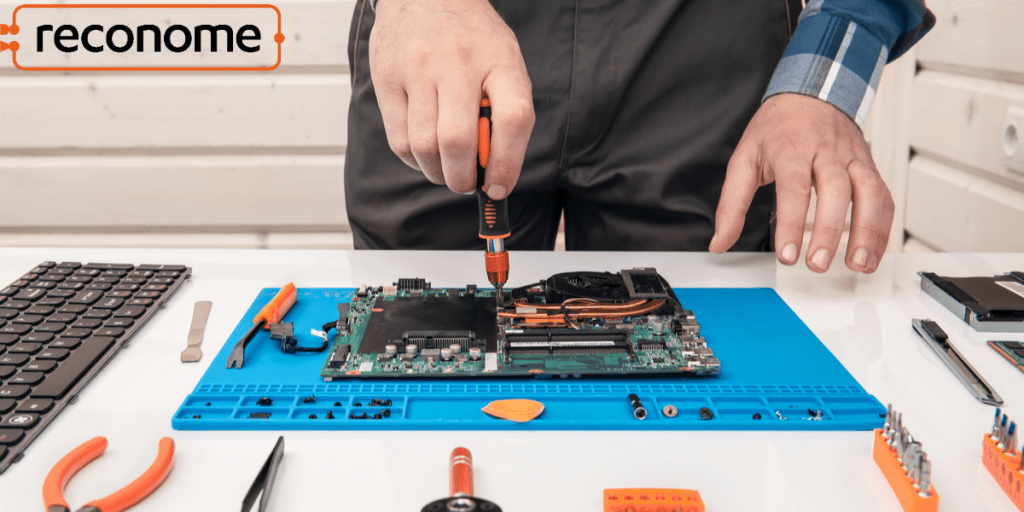Refurbished, Remanufactured or Recycled IT?
Which should you choose, and what is the difference between them?

Although many of us are now purchasing recycled It and electronics alongside other ethically sourced office supplies; to help achieve our CSR and sustainability goals; some confusion remains around the terms refurbished, remanufactured and recycled.
The descriptions will vary depending on where you look, but the IT industry has specific definitions of the three processes.
This article will help you understand their meaning and make informed choices when sourcing IT devices for your school or business.
Before we get into it…
Generally, because the terms are interchangeable and not definitive outside of the industry, each IT Asset Disposal company will use the word they are used to – or that their customers know.
For example, at Reconome, we usually refer to our process as refurbishing for ease of understanding as it’s a term more recognised by our customers. However, the service Reconome provides is, in most cases, ‘remanufacturing’ – even when we refer to it as refurbished.
It’s important to highlight also that the terms refurbished and remanufactured are not the same as second hand. When you purchase second hand, it is unlikely your item(s) will come with a quality guarantee, and they will rarely have a warranty.
Remanufactured equipment
This includes any technological device that has been restored to its original condition through refurbishment. It differs from refurbishment in that it is a complete process: a remanufactured device should not feel ‘previously used’ and must meet customer expectations the same way a brand new device does.
When remanufacturing a device, the engineer will use the same specifications as when originally manufactured, although a combination of parts is used: reused, repaired or brand new. Worn out or obsolete components are replaced, as are the elements affecting the whole device’s performance or expected life.
Refurbished equipment
This process involves a thorough check of products for defects and restores them less expensively than remanufacturing. Once refurbished, the products are usually tested for functionality and defects before they are sold.
Refurbished products can sometimes be unused customer returns, and they can also be unwanted items donated to a business or charity.
Or they may be returned products, still under their original warranty. In this circumstance, they are essentially still new, and the original manufacturer usually undertakes the refurbishment and resells after making the necessary repairs to fix the defects.
Recycled IT equipment
The term ‘recycled’ is used when materials are either converted into reusable materials – or returned to their original state.
When referring to IT, it’s usually a catch-all term that could mean either of the two processes: refurbished or remanufactured. It can be misleading, as the products in question can be used again (so are recycled), but you need to know which process the items have been through. So practice due diligence and research thoroughly before deciding what to purchase.
A sensible solution for schools and businesses
Consumers’ lack of knowledge may lead to an assumption that refurbishing or remanufacturing means the IT devices are of low quality. But both options are attractive economic and environmentally friendly solutions when sourcing IT devices for your school or business. You can purchase excellent equipment at a fraction of its cost when new!
A sensible solution for the environment
Remanufacturing and most refurbishing processes use fewer virgin materials, consume less energy, and reduce the amount of electronic waste sent to landfills.
And the recent Right To Repair legislation introduced across Europe and America means countries worldwide must enforce a take-back regulation that requires manufacturers to retract their products at the end of their life cycle to reverse the damage we have inflicted on our planet. The legislation also requires the designers and manufacturers of products to think longer-term and produce goods that also come with easier to source components for repairs.
Final takeaways
Typically, when equipment has been remanufactured, the process is more thorough and complicated than refurbishing as it requires a higher level of skill (and time) from the engineer. But as it can be more costly, the refurbishment will be a good second choice if budget is an issue.
If the company you have asked to source your equipment cannot meet the definition of remanufactured as above or meet/exceed the Original Equipment Manufacturer (OEM) specifications, the products are, technically, refurbished.
As consumer knowledge and confidence increase, the ability to choose the right IT devices – refurbished or remanufactured – will be easier. Here are a few essential questions you can ask your supplier when purchasing refurbished or remanufactured IT devices…
- Ask how they define the terms Recycled, Refurbished, Remanufactured
- Decide which best fits your needs. Our recommendation is to opt for the best you can afford.
- Ask if the devices come with a warranty.
- Choose a reputable company with proof of a high level of client satisfaction.
If you’d like to understand more about purchasing IT devices that are remanufactured or refurbished, contact our team – we would be happy to help!
Take a look at more of our news and articles here.